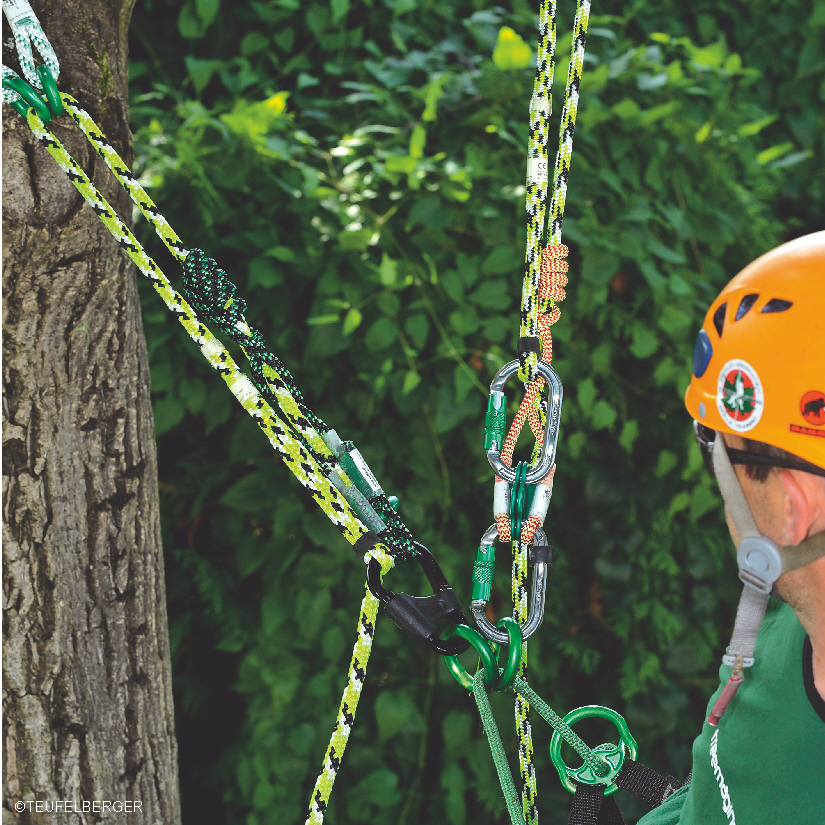
Working with two ropes… the lowdown
Unless you’ve had your head too far up in the clouds recently, then undoubtedly you’ll have heard that the HSE now insist all climbers have two lines, and ideally two independent anchor points, whilst carrying out tree work at height.
The team at Landmark Trading have been keeping a finger on the pulse of this hotly debated subject and we’ve set out a summary below.
What exactly is the new two rope requirement?
In a nutshell, all tree work at height should – wherever practicably possible – be carried out with two independent lines installed over two independent anchor points at all times, with the additional system acting as a backup in the event that the other one becomes damaged or somehow fails. If this is not possible, then both ropes should be installed over a single anchor point.
If after careful consideration and risk assessment it be deemed that neither of the above are reasonably practicable – i.e., the cost or resource required to implement a second rope would be significantly disproportionate to the reduction of risk – or, that a two-rope system can be clearly shown to put workers at increased risk, then one rope and one anchor point can be used; however, detailed explanations should be employed to clearly evidence this.
What are the regulations and why have they been enforced?
The Working at Height Regulations (WaHR) came into force in 2005. As you’d expect from these regulations, they were originally implemented with the aim of reducing serious accidents and fatalities for all industries working at height, and with a view for the whole processes of working at height being managed in a more strategic and effective way.
Having found that these regulations were only being loosely adhered to in the arb industry, and often interpreted quite differently from one arborist to another, the HSE have now made it compulsory for the arborist industry to be fully compliant with the Working at Height Regulations (WaHR) 2005, which require that two ropes are used at all times when working at height.
“Climbing and working with a single rope has remained the custom and practice in the industry for too long and been a factor in many falls from height. Recognising this, some clients in the utility sector have shown the way forward by ensuring their contractors use a backup system. HSE strongly support efforts by the AA to promote this system of work through its publications so that more climbers and businesses understand it is necessary to reduce risk and comply with the law.”
-Stuart Parry, HM Inspector of Health and Safety
What are the benefits?
- A second line could prevent fatal and or/ serious falls from occurring.
- More stringently implemented regulations could mean less untrained and unskilled tree workers entering into the industry.
- Some arborists already implement this practice, and so for those there’s nothing to change!
What are the challenges?
- The introduction of an additional rope can add more complexity and more time working at height.
- More complex systems will potentially lead to more mistakes and therefore compromise safety.
- Having a second line is sometimes very challenging, for example when working in tight space on the ground where extra ropes can get in the way.
- The numbers of HSE officers that are actually trained to assess and inspect arborist sites are limited, therefore is the industry really getting the best advice?

FAQ’s
- Do I have to implement this new system?
Yes. HSE expect all tree workers to be fully compliant with the regulations with immediate effect.
- Do I need two separate ropes or can both ends of the same rope be used?
The current guidance on this still requires further clarification. A revised ICoP (Industry Code of Practice) and updated guide “AA Technical Guide: Tree Climbing and Aerial Rescue (TG1)” are due to be released in Spring 2020 which will provide detailed and practical advice on the use of two lines.
- Do both ropes have to reach the ground, or just one of them?
At least one of the rope systems must be able to reach the ground, clear of any obstacles to provide the user with an easy route down in the event of a self-rescue situation. In normal circumstances the climber is in any case expected to remain connected to both their lines whilst descending.
- Does this include SRT as well as DDRT?
Yes. The regulations apply to all tree climbing operations regardless of the technique.
- Where can my team get additional training in this?
Please visit The Arboricultural Association – www.trees.org.uk or Lantra – www.lantra.co.uk for further information on training and courses.
- What about aerial rescue – are two ropes required for this?
If needed aerial rescue can be performed using one personal fall protection system.
And finally…how can we help?
We understand that these regulations have caused quite a bit of consternation and debate in the industry – as indeed may be expected with a change as significant as this. However, for informative and helpful advice on any of your additional equipment requirements, rest assured that you’ll not only be getting sound and honest information, but a fantastic and friendly service too.
Further information on this topic can be found via the following links:
https://www.hse.gov.uk/treework/safety-topics/climbing-operations.htm
https://www.trees.org.uk/Help-Advice/Public/Background-to-the-HSE-decision-on-two-rope-working
https://www.trees.org.uk/Help-Advice/Public/Personal-Fall-Protection-Systems
https://www.trees.org.uk/News-Blog/Latest-News/Two-rope-working-%E2%80%93-an-update
